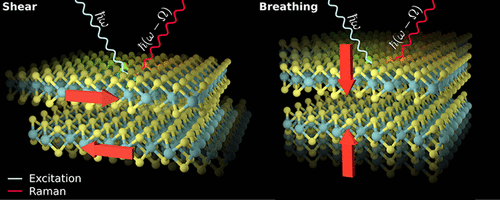Our official English website, www.x-mol.net, welcomes your
feedback! (Note: you will need to create a separate account there.)
Low-Frequency Shear and Layer-Breathing Modes in Raman Scattering of Two-Dimensional Materials
ACS Nano ( IF 15.8 ) Pub Date : 2017-11-17 00:00:00 , DOI: 10.1021/acsnano.7b06551 Liangbo Liang 1 , Jun Zhang 2, 3 , Bobby G. Sumpter 1, 4 , Qing-Hai Tan 2, 3 , Ping-Heng Tan 2, 3 , Vincent Meunier 5
ACS Nano ( IF 15.8 ) Pub Date : 2017-11-17 00:00:00 , DOI: 10.1021/acsnano.7b06551 Liangbo Liang 1 , Jun Zhang 2, 3 , Bobby G. Sumpter 1, 4 , Qing-Hai Tan 2, 3 , Ping-Heng Tan 2, 3 , Vincent Meunier 5
Affiliation

|
Ever since the isolation of single-layer graphene in 2004, two-dimensional layered structures have been among the most extensively studied classes of materials. To date, the pool of two-dimensional materials (2DMs) continues to grow at an accelerated pace and already covers an extensive range of fascinating and technologically relevant properties. An array of experimental techniques have been developed and used to characterize and understand these properties. In particular, Raman spectroscopy has proven to be a key experimental technique, thanks to its capability to identify minute structural and electronic effects in nondestructive measurements. While high-frequency (HF) intralayer Raman modes have been extensively employed for 2DMs, recent experimental and theoretical progress has demonstrated that low-frequency (LF) interlayer Raman modes are more effective at determining layer numbers and stacking configurations and provide a unique opportunity to study interlayer coupling. These advantages are due to 2DMs’ unique interlayer vibration patterns where each layer behaves as an almost rigidly moving object with restoring forces corresponding to weak interlayer interactions. Compared to HF Raman modes, the relatively small attention originally devoted to LF Raman modes is largely due to their weaker signal and their proximity to the strong Rayleigh line background, which previously made their detection challenging. Recent progress in Raman spectroscopy with technical and hardware upgrades now makes it possible to probe LF modes with a standard single-stage Raman system and has proven crucial to characterize and understand properties of 2DMs. Here, we present a comprehensive and forward-looking review on the current status of exploiting LF Raman modes of 2DMs from both experimental and theoretical perspectives, revealing the fundamental physics and technological significance of LF Raman modes in advancing the field of 2DMs. We review a broad array of materials, with varying thickness and stacking configurations, discuss the effect of in-plane anisotropy, and present a generalized linear chain model and interlayer bond polarizability model to rationalize the experimental findings. We also discuss the instrumental improvements of Raman spectroscopy to enhance and separate LF Raman signals from the Rayleigh line. Finally, we highlight the opportunities and challenges ahead in this fast-developing field.
中文翻译:

二维材料拉曼散射的低频剪切和呼吸模式
自2004年隔离单层石墨烯以来,二维分层结构一直是研究最广泛的材料类别之一。迄今为止,二维材料(2DM)池以不断加快的速度增长,并且已经涵盖了众多引人入胜的与技术相关的特性。已经开发了一系列实验技术,并用于表征和理解这些特性。特别地,由于拉曼光谱仪能够识别无损测量中的微小结构和电子效应,因此已被证明是一项关键的实验技术。尽管高频(HF)层内拉曼模式已广泛用于2DM,最近的实验和理论进展表明,低频(LF)层间拉曼模式在确定层数和堆叠构型方面更有效,并且为研究层间耦合提供了独特的机会。这些优势归因于2DM独特的层间振动模式,其中每个层都表现为几乎是刚性移动的物体,并具有与弱层间相互作用相对应的恢复力。与HF拉曼模式相比,最初专注于LF拉曼模式的注意力相对较小,主要是由于它们的信号较弱以及它们与强瑞利线背景的接近性,这使它们的检测工作以前颇具挑战性。随着技术和硬件升级,拉曼光谱技术的最新进展现已使使用标准的单级拉曼系统探测低频模式成为可能,并且事实证明,对于表征和理解2DM的性能至关重要。在这里,我们从实验和理论的角度对2DM的LF拉曼模式的开发现状进行了全面而具有前瞻性的回顾,揭示了LF拉曼模式在推动2DM领域发展方面的基本物理和技术意义。我们审查了具有不同厚度和堆叠构型的各种材料,讨论了平面内各向异性的影响,并提出了广义的线性链模型和层间键极化性模型来合理化实验结果。我们还将讨论拉曼光谱仪的仪器改进,以增强和分离来自瑞利线的低频拉曼信号。最后,我们强调了这个快速发展领域中的机遇与挑战。
更新日期:2017-11-19
中文翻译:

二维材料拉曼散射的低频剪切和呼吸模式
自2004年隔离单层石墨烯以来,二维分层结构一直是研究最广泛的材料类别之一。迄今为止,二维材料(2DM)池以不断加快的速度增长,并且已经涵盖了众多引人入胜的与技术相关的特性。已经开发了一系列实验技术,并用于表征和理解这些特性。特别地,由于拉曼光谱仪能够识别无损测量中的微小结构和电子效应,因此已被证明是一项关键的实验技术。尽管高频(HF)层内拉曼模式已广泛用于2DM,最近的实验和理论进展表明,低频(LF)层间拉曼模式在确定层数和堆叠构型方面更有效,并且为研究层间耦合提供了独特的机会。这些优势归因于2DM独特的层间振动模式,其中每个层都表现为几乎是刚性移动的物体,并具有与弱层间相互作用相对应的恢复力。与HF拉曼模式相比,最初专注于LF拉曼模式的注意力相对较小,主要是由于它们的信号较弱以及它们与强瑞利线背景的接近性,这使它们的检测工作以前颇具挑战性。随着技术和硬件升级,拉曼光谱技术的最新进展现已使使用标准的单级拉曼系统探测低频模式成为可能,并且事实证明,对于表征和理解2DM的性能至关重要。在这里,我们从实验和理论的角度对2DM的LF拉曼模式的开发现状进行了全面而具有前瞻性的回顾,揭示了LF拉曼模式在推动2DM领域发展方面的基本物理和技术意义。我们审查了具有不同厚度和堆叠构型的各种材料,讨论了平面内各向异性的影响,并提出了广义的线性链模型和层间键极化性模型来合理化实验结果。我们还将讨论拉曼光谱仪的仪器改进,以增强和分离来自瑞利线的低频拉曼信号。最后,我们强调了这个快速发展领域中的机遇与挑战。











































 京公网安备 11010802027423号
京公网安备 11010802027423号